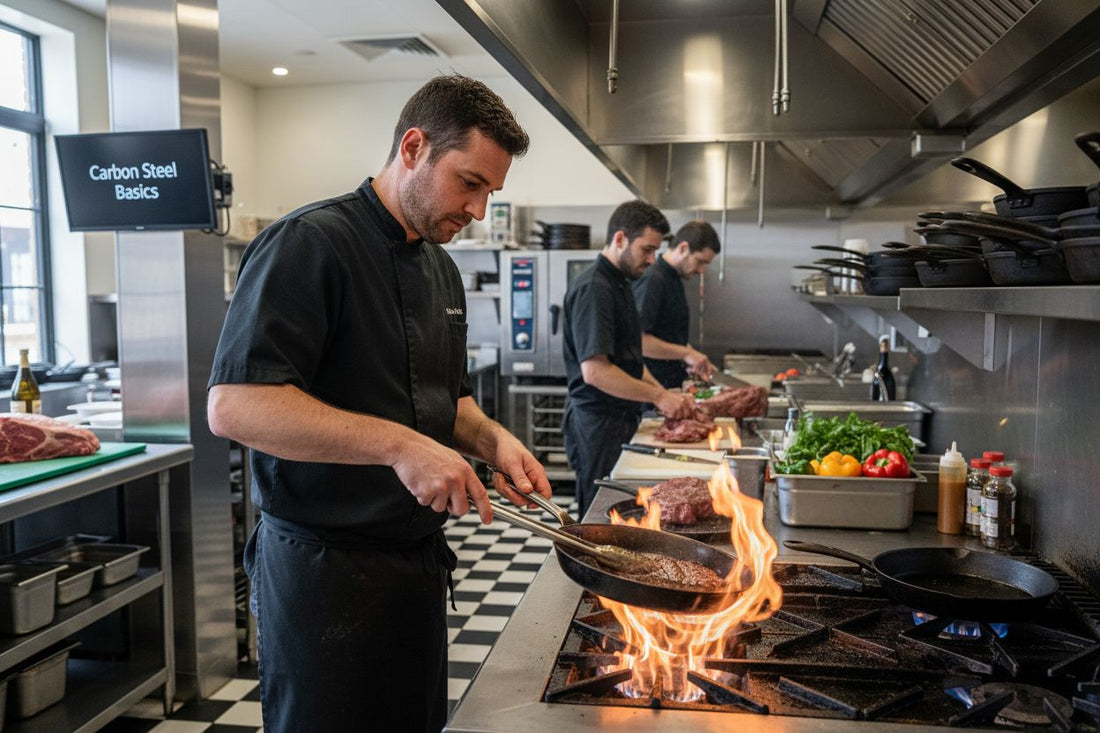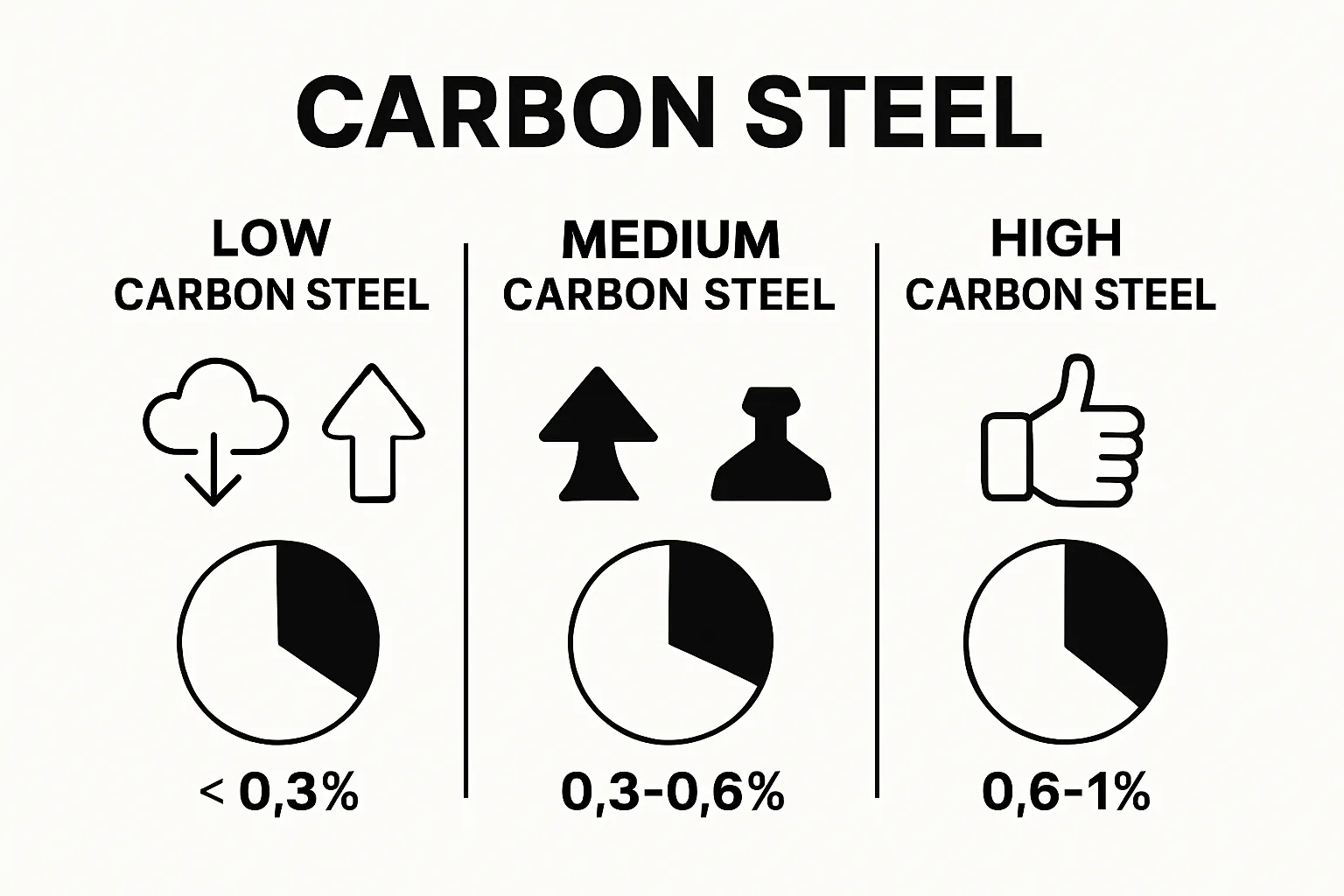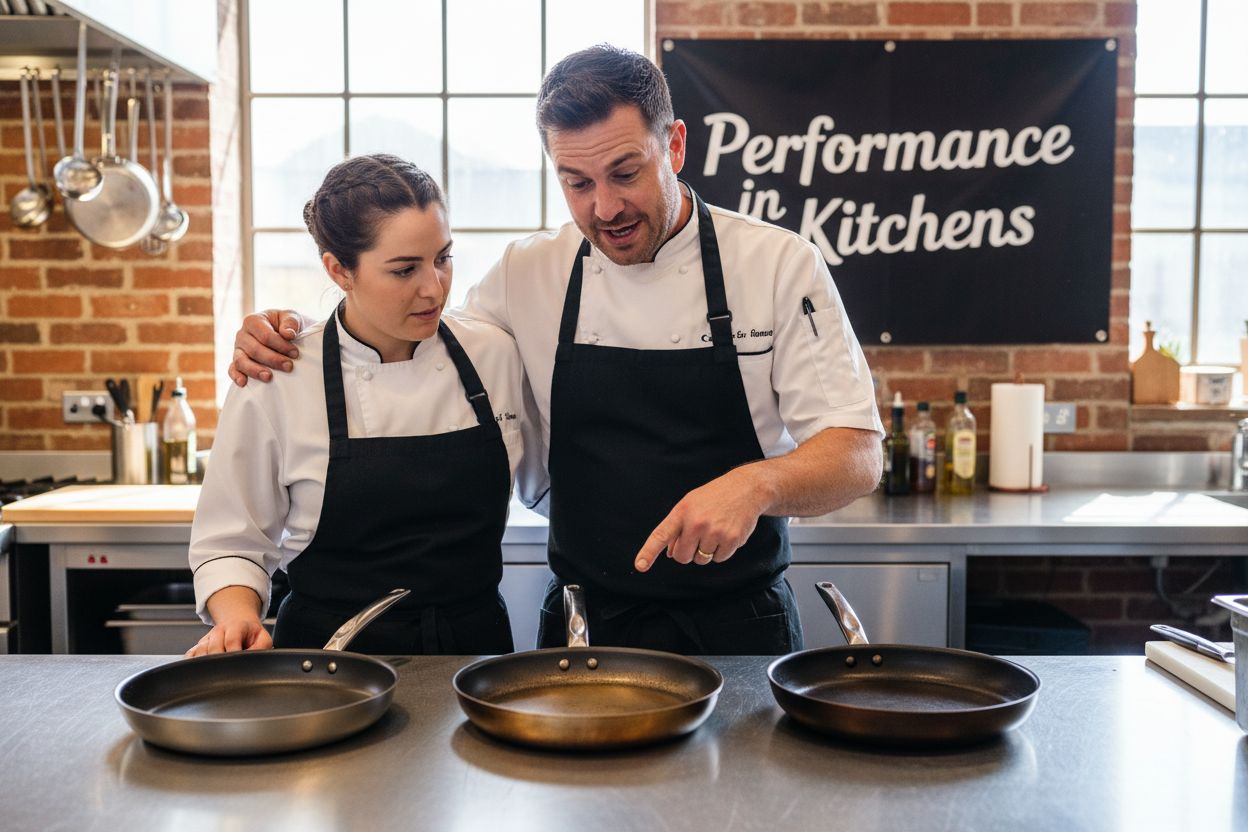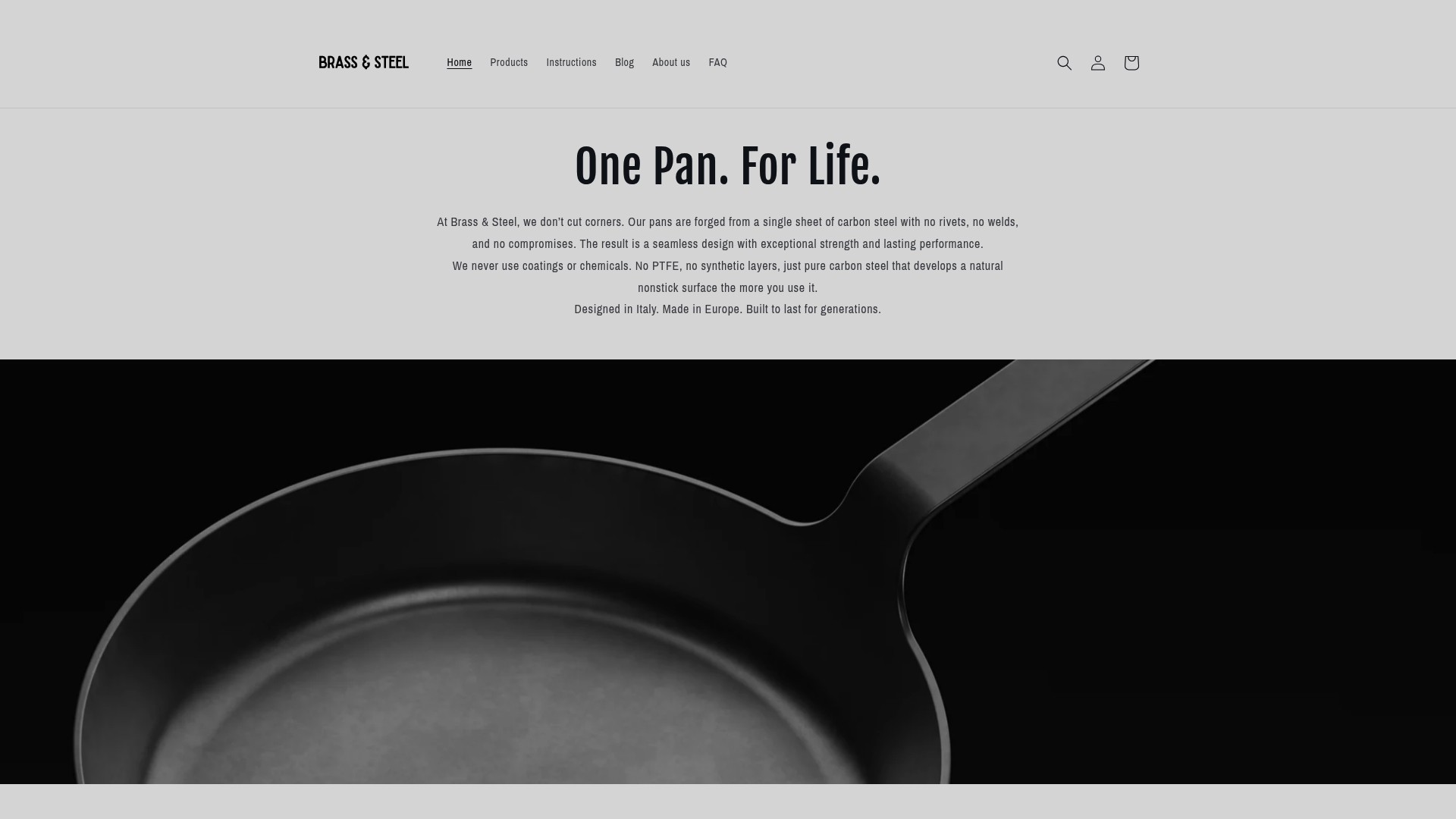
Understanding Carbon Steel for Steakhouse Kitchens
Share
Carbon steel sits at the heart of professional steakhouse kitchens, shaping everything from legendary seared steaks to delicate sauces. You might think stainless steel or cast iron rule the kitchen, but carbon steel can reach cooking temperatures of over 300 degrees Celsius in minutes and develops a natural non stick surface as it’s used. That surface gets better every time you cook, so your pan actually improves with age instead of wearing out.
Table of Contents
- The Basics Of Carbon Steel: Definition And Composition
- Why Carbon Steel Matters In Steakhouse Cooking
- How Carbon Steel Contributes To Optimal Cooking Performance
- Key Characteristics Of Carbon Steel Cookware
- Real-World Applications Of Carbon Steel In Steakhouse Kitchens
Quick Summary
| Takeaway | Explanation |
|---|---|
| Carbon steel offers superior heat management. | Its high thermal conductivity allows for rapid and even heat distribution, essential for precise cooking. |
| Durability ensures long-lasting performance. | Carbon steel withstands intense use in professional kitchens, maintaining structural integrity over time. |
| Natural seasoning improves cooking performance. | The progressive patina developed through use enhances non-stick properties and adds flavour. |
| Versatile for various cooking techniques. | Chefs can use carbon steel for multiple culinary tasks, from searing to delicate sauces. |
| Optimal for steakhouse environments. | Carbon steel’s properties are perfect for achieving restaurant-quality results in steak preparation and cooking processes. |
The Basics of Carbon Steel: Definition and Composition
Carbon steel represents a critical material in culinary engineering, combining iron and carbon to create a robust and versatile metal. Carbon steel is fundamentally an alloy where iron is combined with carbon in varying proportions, typically ranging between 0.05% and 2.1% carbon by weight.
Chemical Composition and Properties
The precise carbon content determines the steel’s fundamental characteristics.
 These percentages create significant variations in mechanical properties:
These percentages create significant variations in mechanical properties:
- Low carbon steel (0.05 to 0.25% carbon): Softer and more ductile
- Medium carbon steel (0.25 to 0.60% carbon): Stronger with improved hardness
- High carbon steel (0.60 to 2.1% carbon): Extremely hard but less malleable
For steakhouse kitchens, medium carbon steel offers an optimal balance between strength, heat conductivity, and workability. The small quantities of additional elements like manganese, silicon, and copper further enhance its performance characteristics.
The following table summarises the different types of carbon steel as described in the article, highlighting their carbon content and key physical properties.
| Type of Carbon Steel | Carbon Content by Weight | Key Characteristics |
|---|---|---|
| Low carbon steel | 0.05% to 0.25% | Softer, more ductile |
| Medium carbon steel | 0.25% to 0.60% | Stronger, improved hardness |
| High carbon steel | 0.60% to 2.1% | Extremely hard, less malleable |
Performance in Culinary Applications
In professional kitchen environments, carbon steel’s unique properties make it an exceptional material for cookware. Its rapid and uniform heat distribution allows chefs to achieve precise temperature control, critical for perfectly seared steaks and delicate cooking techniques.
The material’s natural ability to develop a seasoned patina over time creates a near nonstick surface without artificial chemical coatings. Read more about carbon steel health benefits in our comprehensive guide to understand how this remarkable material supports both culinary performance and wellness considerations.
Carbon steel’s versatility extends beyond heat conductivity. Its durability means professional kitchen tools can withstand intense, repeated use while maintaining structural integrity and consistent cooking performance.
Why Carbon Steel Matters in Steakhouse Cooking
Carbon steel has transformed professional kitchen equipment, particularly in steakhouse environments where precision cooking techniques demand exceptional performance. Its unique material properties make it a superior choice for chefs seeking unparalleled culinary results.
Superior Heat Management
The extraordinary heat conductivity of carbon steel sets it apart from other cookware materials. Unlike traditional pans, carbon steel distributes heat rapidly and uniformly, creating perfect conditions for achieving that coveted restaurant quality sear. Professional chefs value its ability to:
- Reach extremely high temperatures quickly
- Maintain consistent heat across the cooking surface
- Respond immediately to temperature adjustments
- Create exceptional caramelisation and Maillard reactions
This remarkable thermal performance means steaks develop a stunning golden crust while remaining perfectly tender inside.
Learn more about cooking techniques in our comprehensive steak guide.
Durability and Professional Performance
Steakhouse kitchens demand equipment that withstands intense, repeated use. Carbon steel excels in this environment, offering exceptional durability without compromising cooking performance. Its robust construction ensures longevity, resisting warping and maintaining structural integrity even under extreme cooking conditions.
The natural seasoning process of carbon steel creates a progressively improving cooking surface. With each use, the pan develops a non stick patina that enhances flavour profiles and reduces the need for excessive cooking oils. Professional kitchens appreciate this self improving characteristic, which transforms the cookware from a mere tool to a culinary asset that grows more effective over time.
How Carbon Steel Contributes to Optimal Cooking Performance
Carbon steel transcends traditional cookware functionality by offering a sophisticated combination of thermal dynamics and material engineering that elevates culinary precision. Its performance characteristics make it an unparalleled choice for professional chefs seeking absolute control over cooking techniques.
Thermal Responsiveness and Control
The molecular structure of carbon steel enables extraordinary heat management that distinguishes it from other cooking materials. Its thermal conductivity allows for:
- Rapid temperature adjustment within seconds
- Minimal thermal lag during cooking processes
- Uniform heat distribution across the entire cooking surface
- Precise temperature modulation for complex cooking techniques
This exceptional thermal performance means chefs can seamlessly transition between high heat searing and gentle cooking methods without compromising food quality. Understand the nuanced differences between cookware materials in our comprehensive guide.
Structural Integrity and Cooking Dynamics
Carbon steel’s unique molecular composition provides remarkable structural advantages that directly impact cooking performance. The material develops a natural non stick surface through seasoning, which improves with repeated use. This progressive enhancement means each cooking session incrementally refines the pan’s performance.
Professional kitchens value carbon steel for its ability to withstand extreme temperatures while maintaining consistent mechanical properties. Unlike alternative materials that degrade or warp, carbon steel preserves its structural integrity, ensuring reliable and predictable cooking results across hundreds of service cycles.
The material’s inherent characteristics allow for nuanced heat transfer that preserves ingredient integrity, enabling chefs to achieve perfect caramelisation, precise protein sealing, and exceptional flavour development in every dish.
Key Characteristics of Carbon Steel Cookware
Carbon steel cookware represents a sophisticated fusion of metallurgical engineering and culinary performance, offering professional chefs a versatile and robust cooking tool. Its distinctive characteristics set it apart from conventional cookware materials, providing exceptional functionality across diverse cooking scenarios.
Material Composition and Physical Properties
Carbon steel’s unique composition delivers remarkable performance characteristics that professional kitchens demand. The material’s core attributes include:
- High thermal conductivity enabling rapid and uniform heat distribution
- Exceptional durability and resistance to mechanical stress
- Lightweight construction compared to cast iron alternatives
- Natural non toxic surface that improves with seasoning
Explore the comprehensive benefits of carbon steel cookware in our detailed guide to understand its transformative potential in professional cooking environments.
Surface Interaction and Culinary Performance
The dynamic surface characteristics of carbon steel distinguish it from other cookware materials. Unlike synthetic non stick surfaces that degrade over time, carbon steel develops a natural patina through repeated use. This progressive seasoning creates an increasingly effective cooking surface that:
- Enhances flavour development
- Reduces required cooking oils
- Provides natural non stick properties
- Prevents food from adhering during high temperature cooking
Professional chefs appreciate how carbon steel cookware becomes more refined with each cooking session, transforming from a simple utensil into a sophisticated culinary instrument that adapts and improves through consistent use.

Real-World Applications of Carbon Steel in Steakhouse Kitchens
Carbon steel transcends theoretical performance, proving itself as an indispensable tool in professional steakhouse environments where precision, durability, and consistent results are non negotiable. Its versatility enables chefs to execute complex cooking techniques with unprecedented control and efficiency.
Versatile Cooking Techniques
Professional steakhouse kitchens leverage carbon steel’s exceptional properties across multiple cooking methods. Chefs rely on these pans for:
- Perfectly seared steaks with golden brown crust
- High temperature meat browning
- Rapid temperature transitions for delicate protein management
- Consistent heat distribution for complex multi stage cooking processes
The material’s remarkable thermal responsiveness allows chefs to achieve restaurant grade results consistently, transforming ordinary ingredients into extraordinary culinary experiences. Discover advanced maintenance techniques to preserve your cookware’s performance.
Specialized Kitchen Applications
Carbon steel’s adaptable performance extends beyond traditional steak preparation. Professional kitchens utilise these pans for diverse culinary tasks that demand precise thermal control. From creating delicate pan sauces to executing complex reduction techniques, carbon steel provides chefs with an unparalleled cooking instrument.
The material’s ability to withstand extreme temperatures while maintaining structural integrity makes it ideal for multiple cooking techniques. Chefs can seamlessly transition from stovetop searing to oven finishing, all within the same pan, reducing equipment requirements and streamlining kitchen workflow.
Take Steakhouse Precision Into Your Own Kitchen
Perfect caramelisation, rapid heat response and tough reliability are not just the dreams of professional steak chefs. If your search for the perfect carbon steel pan is driven by disappointment with flimsy alternatives, chemical coatings, or uneven heat, the solution is much closer than you think. Our Carbon Steel Collection is forged in one seamless piece for maximum durability, naturally nonstick performance and effortless maintenance. Each pan is designed for chefs who demand flawless results every time.

Join cooks across Europe who are trading in their frustration for cookware that truly lasts. Explore the full range and transform your steakhouse experience at Brass & Steel. Take home a pan that becomes better with every use and discover what true culinary control feels like. Shop today and revolutionise your approach to professional-grade steak cooking.
Frequently Asked Questions
What is carbon steel and how is it composed?
Carbon steel is an alloy of iron and carbon, typically containing between 0.05% and 2.1% carbon by weight. The carbon content affects its properties, with lower percentages offering softness and ductility, while higher percentages provide strength and hardness.
What are the benefits of using carbon steel cookware in steakhouse kitchens?
Carbon steel cookware offers superior heat conductivity, allowing for rapid and uniform heat distribution, essential for achieving perfect sears on meats. Its durability and ability to develop a natural non-stick patina make it ideal for professional cooking environments.
How does carbon steel compare to other materials like cast iron or traditional non-stick pans?
Carbon steel is lighter than cast iron and has higher thermal responsiveness than many traditional non-stick pans. Unlike synthetic non-stick coatings, carbon steel develops a natural non-stick surface over time, improving with each use.
This table compares the features and benefits of carbon steel cookware with those of cast iron and traditional non-stick pans, based directly on the discussion within the content.
| Feature | Carbon Steel | Cast Iron | Traditional Non-Stick Pans |
|---|---|---|---|
| Weight | Lighter | Heavier | Light to medium |
| Heat Conductivity | High, rapid and even | Moderate, slow heating | Moderate |
| Thermal Responsiveness | Excellent | Slow | Moderate to good |
| Non-stick Surface | Develops natural patina with use | Develops seasoning with use | Synthetic coating, can degrade |
| Durability | Withstands intense use, improves | Very durable but can chip/crack | Coating may wear off over time |
| Maintenance | Requires regular seasoning | Requires regular seasoning | Easier, but avoid metal utensils |
How do I maintain and care for my carbon steel cookware?
To maintain carbon steel cookware, it is important to season it regularly, which involves applying a thin layer of oil and heating it. This enhances its non-stick properties and protects it from rust. Avoid using soap, and instead, clean with hot water and a gentle scrubber.